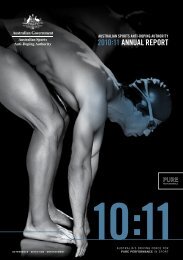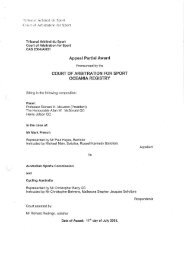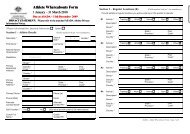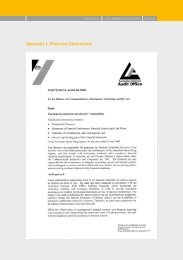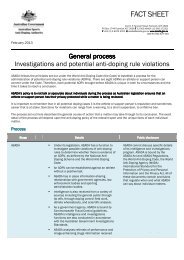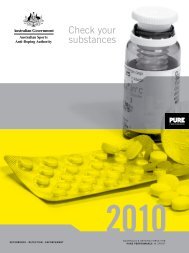Australian Sports Anti-Doping Authority :: 2006-07 Annual Report
Australian Sports Anti-Doping Authority :: 2006-07 Annual Report
Australian Sports Anti-Doping Authority :: 2006-07 Annual Report
Create successful ePaper yourself
Turn your PDF publications into a flip-book with our unique Google optimized e-Paper software.
4<br />
OVERVIEW ASADA <strong>Annual</strong> <strong>Report</strong> <strong>2006</strong>:<strong>07</strong><br />
ASADA has redefined detection in anti-doping by building a holistic capability integrating<br />
traditional testing with new powers of investigation that comply with the <strong>Australian</strong><br />
Government Investigations Standards. Combined with the new relationships ASADA has<br />
built in the past year with other government agencies such as the <strong>Australian</strong> Customs<br />
Service, ASADA has a detection capability greater than ever before.<br />
ASADA conducted 6,953 tests during the past year across 65 sports and 2,220 athletes.<br />
In March, ASADA conducted over 300 tests during two intensive weeks of competition<br />
at the Fédération Internationale de Natation (FINA) World Swimming Championships<br />
in Melbourne. Per capita, Australia has one of the largest testing programs in the world,<br />
which acts as a major deterrent to doping.<br />
During the year, ASADA completed the first of several investigations, examining allegations<br />
of doping in the sport of weightlifting. This investigation proved to be an early test of the<br />
organisation’s capabilities, as ASADA needed to work cooperatively with two state police<br />
forces and an international laboratory to fully examine the allegations.<br />
As a result of this groundbreaking investigation, five athletes and/or athlete support<br />
personnel from the sports of weightlifting and power lifting were placed on the Register<br />
of Findings (RoF) for a range of serious doping violations. These included use, possession,<br />
or trafficking of prohibited substances such as stimulants, steroids and human growth<br />
hormone (hGH). Sanctions applied to these offences have ranged from two years to<br />
lifetime bans from sporting competition.<br />
While testing can detect many forms of doping, it cannot detect serious violations such<br />
as possession and trafficking. To complement traditional testing, ASADA has a strong<br />
investigative capability that represents a new and powerful front in the fight against the<br />
most serious forms of doping in <strong>Australian</strong> sport.<br />
Enforcement<br />
ASADA’s enforcement activities represent another new function developed in the debut<br />
year of operations. Analysing case materials, preparing evidentiary briefs and arguing<br />
cases before the relevant sporting tribunal, the role of ASADA’s Enforcement unit is<br />
to apply the Code fairly and firmly when athletes or support personnel have violated<br />
anti‐doping rules.<br />
During the past year, 24 athletes and athlete support personnel were found to be in<br />
violation of Australia’s strict anti-doping rules. For the first time, application of ASADA’s<br />
new powers has seen athletes sanctioned for using substances that traditional testing<br />
cannot detect.





